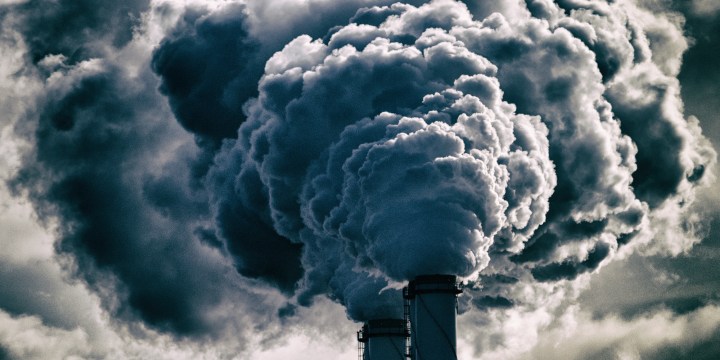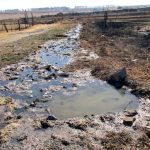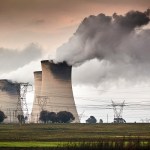DIRTY TALK
Despite a drop in greenhouse gas emissions in the past decade, SA is still a shockingly high emitter

SA’s greenhouse gas emissions have decreased in the past two decades, in part owing to a crumbling energy sector and the Covid-19 pandemic, but despite what many African leaders like to point out, SA’s emissions are not as low as we like to imagine.
Last week, the Minister of Forestry, Fisheries and the Environment, Barbara Creecy, published South Africa’s 8th National Greenhouse Gas Inventory Report, which details SA’s annual greenhouse gas (GHG) emissions from 2000 to 2020.
Believe it or not, the inventory shows that South Africa’s net emissions decreased marginally from 2000-2020, by about 0.8%. At the start of the century, our net GHG emissions in carbon dioxide equivalent (C0₂e) were 446 million tonnes and by 2020 they had declined to 442 million tonnes.
Climate and biodiversity scientist and acting director of the School for Climate Studies at Stellenbosch University, Professor Guy Midgley, explained to Daily Maverick that (C0₂e) includes other polluting gases such as methane – which is about 20 times as strong as C0₂ – and nitrous oxide, which are converted mathematically into their C0₂ equivalent to get a global warming potential.
As illustrated in the graph, emissions started to decrease in 2010, around the time (2008) that load shedding became prominent in the face of insufficient generation capacity needed to meet the country’s energy demands. Midgley said the interesting thing to note was how the emissions peaked in 2009 and had come down – “we’re basically almost back to where we were in 2001”.
He added that, since the decay of Eskom, “there’s been a very significant shift. You know, a lot of industries have basically shut down”.
The Department of Forestry, Fisheries and the Environment’s (DFFE) inventory report showed that the gas contributing the most to South Africa’s emissions is C0₂, at 83.6% in 2020, and that the energy sector was by far the largest contributor to C0₂ emissions, at 94.7% in 2020.
The inventory was compiled in accordance with the guidelines provided by the United Nations Framework Convention on Climate Change (UNFCCC), which is one of the UN’s three environmental treaties that the Republic of South Africa ratified in August 1997, joining the majority of countries in the international community.
“The GHG inventory is central to tracking the implementation of South Africa’s Nationally Determined Contribution (NDC),” said Creecy.
Under the Paris Agreement – an international treaty adopted by 196 parties (including SA) at the UN Climate Change Conference (COP21) in Paris, in 2015 – nations are required to submit NDCs every five years, as a mechanism to help track and reduce national emissions.
SA submitted its first NDC in 2015, committing the country to keeping its national GHG emissions within a range from 389 metric tonnes of C0₂e for 2025 and 2050.
“We are proud of the robust format of our monitoring which has been developed over the past 15 years, and includes both public comment and independent verification and is designed to support domestic and international reporting obligations,” said Creecy.
Covid caused a dip in emissions
The inventory reported that GHG emissions declined by 5.9% between 2017 and 2020, primarily as a result of the Covid-19 pandemic, but the DFFE acknowledged that preliminary assessment using data from Sagers (South African Greenhouse Gas Emissions Reporting System) for 2021 shows that some of the emission sources have increased compared with 2020 levels.
“This implies that from 2021 onwards the most carbon-intensive assets are likely to return to pre-Covid emission rates,” the DFFE said. “This is in line with international trends as can be observed from developed country GHG emission inventory submissions for 2021 that were filed with the UNFCCC in April 2023.”
Where do we stand globally?
Many African leaders have argued that as the continent has contributed the least amount of GHG emissions historically, its inhabitants are the least responsible for climate change – with the Executive Council of the African Union (AU) developing an “African Common Position” on energy access and resource development last year, which saw fossil fuels playing a crucial role in expanding African economies and energy access.
And last week at the Solar & Future Energy Show Africa, the Minister of Electricity, Kgosientsho Ramokgopa, noted in a presentation to independent power producers, government officials, large energy users, solution providers and academics, that Africa has since 1890 accounted for less than 4% of global energy‐related C0₂ emissions and has the lowest emissions per capita in the world.
“That’s why when we go to COP [UN climate change conference] we speak about equal but differentiated responsibilities,” the minister said. “The developed and industrialised world … need to invest on the continent in areas around new innovation, the expansion of the industrial capacity, so that Africa can also rise.”
The minister added that “we’re committed to the decarbonisation agenda – but the industrialised … have got the responsibility to contribute towards that transition.”
Ramokgopa clarified later to Daily Maverick that he didn’t mean that this justified South Africa investing in fossil fuels, like other AU leaders.
The top three GHG emitters globally are China, followed by the US and then India – although cumulatively, the US has emitted more C0₂ than any other country, at around 400 billion tonnes since 1751 and it is responsible for 25% of historical emissions.
While what Ramokgopa highlighted is true, Lauri Myllyvirta, lead analyst at the Centre for Research on Energy and Clean Air, told Daily Maverick that “the argument about low emissions per capita and historically applies to much of Africa but not so much to South Africa”.
At 436 million tonnes of C0₂ emitted in 2021, South Africa is actually the 14th-largest emitter of CO₂ worldwide in 2021.
Myllyvirta explained that on a per capita basis, SA’s emissions are actually higher than global average, higher than in India and the EU and about the same as in China.
“And for the relatively low GDP per capita level, they’re very high, which speaks to the high carbon intensity of the energy system,” Myllyvirta said.
“Of course, the groundwork for the highly C0₂– and energy-intensive energy system and industrial system dates back to apartheid and ties into past injustices within the country, but progress in cleaning up has been spotty at best afterwards as well,” Myllyvirta noted.
Midgley agreed, pointing out that while our per capita emissions are relatively high – they are disproportionate. “South Africa is chronic in terms of the inequality of greenhouse gas emissions,” said Midgley.
“The vast majority of our population has very low per capita emissions. Rich South Africans have an emissions profile quite similar to rich Americans,” he said, citing studies that have found that the world’s richest 10% are responsible for an estimated 47% share of global CO₂ emissions, and that on average, a person in the lower 50% income group only produces about one tonne of CO₂ per year compared to about 48 tonnes of C0₂ per capita emitted by the wealthiest one percent.
Carbon sinks
“Over the next two decades, South Africa will have to increase its carbon sinks in order to reach the long-term goal of a Net Zero carbon economy and society by 2050,” the DFFE said on the release of the inventory.
“Afforestation, reforestation, reversing of land degradation and grassland management are key activities to achieve this long-term objective.”
The GHG inventory also highlights the role carbon sinks play in lowering the net emissions profile for the country. It lists emissions that include the influence of Forestry and Other Land Use (FOLU) and emissions that exclude FOLU.
“It all depends on the way the land is managed,” Midgely said, explaining how FOLU can impact C0₂e emissions.
“It could be – if you’ve planted a whole bunch of forests, and they’re absorbing C0₂, or if you’ve changed your fire management regime, or if you pile up a whole lot of land to create more farming.”
But Midgely said what was interesting was that if you looked at the emissions that included FOLU, the C0₂e emissions are lower every single year – meaning that forestry and land use absorbs carbon.
South African climate scientist Chris Trisos and Midgley previously pointed out to Daily Maverick that some nature-based solutions for climate change, such as afforestation, could negatively affect biodiversity, like planting alien invasive trees in naturally unforested ecosystems such as African savannas and grasslands.
Read more in Daily Maverick: ‘Greenwashing’ alert – African delegates red-flag nature buzzwords at biodiversity summit
So it’s important to plant the right type of carbon sinks – Midgley explained that grasslands also store loads of carbon, and it’s stored underground.
“I think what people don’t realise is that about 30% of our emissions every year are being absorbed by land ecosystems,” Midgley said.
“If it was not for that sink – we would have far worse global warming by now.” DM/OBP
For tickets to Daily Maverick’s The Gathering Earth Edition, click here.





















We need MORE CO2, not less and not at the cost of cheap energy – without energy there is no economy – without an economy, we cannot do anything for pollution anyway